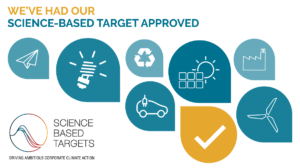Dawn Meats Group has committed to delivering a 30% reduction by 2030 in greenhouse gas emissions from its own facilities and from the generation of the energy it purchases. The targets have been made under the Science Based Targets Initiative (SBTi) which ensures emissions reduction is verified and documented against a scientific baseline. The commitment comes in the wake of the COP25 UN Climate Change Conference in Madrid where political, business and NGO leaders sought to coordinate a collective response to global warming.
The commitment comes in the wake of the COP25 UN Climate Change Conference in Madrid where political, business and NGO leaders sought to coordinate a collective response to global warming.
In May 2019 Dawn Meats Group, which includes Dunbia in the UK, signed up to SBTi becoming the first European beef and lamb processor to make such a commitment. In collaboration with the Carbon Trust, Dawn Meats Group has developed a pathway for its Scope 1 and 2 emissions and is working on solutions for Scope 3 emissions, with 2030 targets now validated and approved by SBTi. Dawn Meats Group has committed to a 30% reduction in absolute Scope 1 and 2 GHG emissions by 2030 from a 2016 base year. Scope 1 emissions are direct emissions from owned or controlled sources and Scope 2 are indirect emissions from the generation of purchased energy. Significant progress has already been made in Scope 1 and Scope 2 emissions reduction in the period up to 2016, through the installation of heat recovery systems, district heating systems and the use of wind and solar powered renewable energy. This work will accelerate in the years to 2030 as technologies improve and the rollout program is completed across the enlarged group.
Dawn Meats Group has further committed to reduce Scope 3 GHG emissions of its purchased goods and services by 28% per tonne of finished product by 2030 from a 2016 base year. Scope 3 emissions are indirect emissions that occur in the value chain of the company, both upstream and downstream, and are from sources which are not owned or controlled by the target setting company. In the case of beef and lamb processing, livestock and meat products constitute the largest share of Scope 3 emissions and therefore present the greatest opportunity to demonstrate improvement over the next 10 years.
